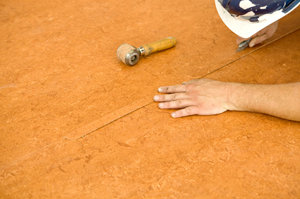Synthetic flooring is a category of material that includes laminate floors, vinyl, linoleum and rubber -- all of which combine man-made substances with naturally-occurring ones to produce a variety of floor covering options. Synthetic flooring may come in sheets, planks, or tiles in a multitude of colors and designs. They are often the preferred material in high-traffic areas as they are easy to maintain; resist stains, scratches, and water; and are comfortable underfoot.

Laminate flooring is made to look like natural wood but is actually an image of wood applied on top of a core layer usually made of resin and fiberboard materials. It is the most popular type of wood flooring used around the world, except in the USA where it is quickly catching up.
Vinyl became popular in the 1950s when new uses for rubber and plastic provided homeowners with less expensive, more versatile, and easily- maintained flooring alternatives. More modern improvements have resulted in vinyl flooring that resembles wood, stone, cork, tiles, and mosaics.
Linoleum, or lino for short, is a floor covering similar to vinyl flooring with an important difference: where the color or image on vinyl is a thin top layer, the color of lino is infused to the depth of the material which means scratches and dents don.t show as much. It is manufactured of renewable materials including solidified linseed oil, pine rosin, ground cork dust, wood flour, and mineral fillers such as calcium carbonate. Lino flooring is usually applied to a burlap or canvas backing.
Rubber flooring may be made from naturally-occurring sources or be synthetically produced. It is available in sheets, tiles, and mats and is valued for being a comfortable surface to stand on for long periods of time. Rubber floors are especially valuable for exercise floors in gyms.
Manufacturers' warranties on synthetic flooring vary by company, materials used, and quality of the product. Reputable producers will cover their products for manufacturing defects, fading, wear-through, and stains but sometimes only for the buyer and not for subsequent homeowners. Installation professionals may also offer warranties covering their work, and important warrantee details should be confirmed prior to signing any contract.
Ease of maintenance and low cost are the most often cited advantages of synthetic flooring. Because they are manufactured -- not grown on trees or dug from the ground as with natural products -- there is no shortage of the material for sale. The surfaces of lino, vinyl, laminate, and rubber flooring are designed to be water and scratch resistant. The cushioned under-layer to most synthetic flooring also makes it more comfortable, especially in the kitchen where standing for long periods of time is common.
Some synthetic flooring materials are valued in non-allergenic homes and health-care facilities because they are made of organic materials (linseed oil, jute, natural rubber) and are purportedly non-allergenic in nature.
Sharp objects dropped on synthetic flooring may damage the surface although materials with high-rubber content should bounce back and show no or very little break. As with all floors, special care should be taken to move heavy furniture or appliances by lifting rather than pushing them across the floor.
While synthetic flooring is often found in health care facilities, there are concerns about the impact of chemicals found in the materials and the adhesives used for installation. The use of resins and volatile organic compounds in synthetic floorings and in the glue applied to the flooring material may affect indoor air quality and affect some people negatively. Some materials emit harmful substances for years after their installation.
Need more information? We also publish consumer reviews of many brands of synthetic flooring.